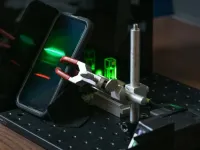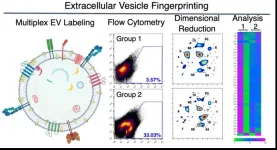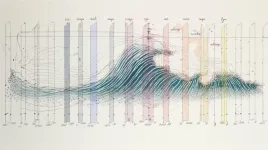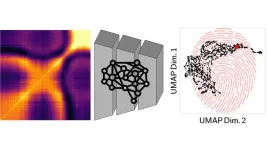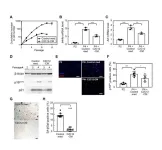(Press-News.org) Imagine knowing what berry or mushroom is safe to eat during a hike or swiftly detecting pathogens in a hospital setting that would traditionally require days to identify.
Identification and detection of drugs, chemicals and biological molecules invisible to the human eye can be made possible through the combined technology of a cellphone camera and a Raman spectrometer — a powerful laser chemical analysis method.
Dr. Peter Rentzepis, a professor in the Department of Electrical and Computer Engineering at Texas A&M University, holds a patent for a hand-held cellphone-based Raman spectrometer system. Rentzepis’ invention allows the user to make non-invasive identifications of potentially harmful chemicals or materials in the field, especially in remote areas where laboratory spectrometers cannot be used due to their size and power needs.
This new Raman spectrometer system integrates lenses, a diode laser and a diffraction grating — a small thin square-shaped surface that scatters light for analysis — in combination with a camera from a cellphone to record the Raman spectrum. Peaks in the spectrum provide detailed data about the chemical composition and molecular structure of a substance, depending on their intensities and positions.
To use the device, a cellphone is placed behind the transmission grating with the camera facing the grating, ready to record the Raman spectrum. A laser shoots a beam into a sample of unknown material, such as a bacterium, on a slide. The camera records the spectrum, and when paired with an appropriate cellphone application/database, this handheld instrument can enable rapid materials identification on site.
Previously, the process of identifying unknown substances involved extensive sampling of biological material and laboratory analysis, which could take several hours or even days. While traditional Raman spectrometers cost up to thousands of dollars, Rentzepis’ invention can be made at a significantly lower cost and can identify materials at a significantly quicker speed.
“It’s a small device that can tell you the composition of a particular system, material or sample,” Rentzepis said. “You can even have it in your pocket.”
Fellow inventors are former graduate students Dr. Dinesh Dhankhar, a system engineer at Thermo Fisher Scientific, and Anushka Nagpal, a process engineer at Intel Corporation.
Funding for this research is administered by the Texas A&M Engineering Experiment Station (TEES), the official research agency for Texas A&M Engineering.
Imagine knowing what berry or mushroom is safe to eat during a hike or swiftly detecting pathogens in a hospital setting that would traditionally require days to identify.
Identification and detection of drugs, chemicals and biological molecules invisible to the human eye can be made possible through the combined technology of a cellphone camera and a Raman spectrometer — a powerful laser chemical analysis method.
Dr. Peter Rentzepis, a professor in the Department of Electrical and Computer Engineering at Texas A&M University, holds a patent for a hand-held cellphone-based Raman spectrometer system. Rentzepis’ invention allows the user to make non-invasive identifications of potentially harmful chemicals or materials in the field, especially in remote areas where laboratory spectrometers cannot be used due to their size and power needs.
This new Raman spectrometer system integrates lenses, a diode laser and a diffraction grating — a small thin square-shaped surface that scatters light for analysis — in combination with a camera from a cellphone to record the Raman spectrum. Peaks in the spectrum provide detailed data about the chemical composition and molecular structure of a substance, depending on their intensities and positions.
To use the device, a cellphone is placed behind the transmission grating with the camera facing the grating, ready to record the Raman spectrum. A laser shoots a beam into a sample of unknown material, such as a bacterium, on a slide. The camera records the spectrum, and when paired with an appropriate cellphone application/database, this handheld instrument can enable rapid materials identification on site.
Previously, the process of identifying unknown substances involved extensive sampling of biological material and laboratory analysis, which could take several hours or even days. While traditional Raman spectrometers cost up to thousands of dollars, Rentzepis’ invention can be made at a significantly lower cost and can identify materials at a significantly quicker speed.
“It’s a small device that can tell you the composition of a particular system, material or sample,” Rentzepis said. “You can even have it in your pocket.”
Fellow inventors are former graduate students Dr. Dinesh Dhankhar, a system engineer at Thermo Fisher Scientific, and Anushka Nagpal, a process engineer at Intel Corporation.
Funding for this research is administered by the Texas A&M Engineering Experiment Station (TEES), the official research agency for Texas A&M Engineering.
By Katie Satterlee, Texas A&M University Engineering
###
END
Pocket-sized invention revolutionizes ability to detect harmful materials
The low-cost cellphone-based Raman spectrometer system can make identifications of unknown biological molecules within minutes
2024-07-16
ELSE PRESS RELEASES FROM THIS DATE:
A new addition to the CRISPR toolbox: Teaching the gene scissors to detect RNA
2024-07-16
Bacteria have developed special defense mechanisms to protect themselves against viruses, which by no means infect only humans. As part of these so-called CRISPR-Cas systems, a CRISPR ribonucleic acid (crRNA), which serves as a “guide RNA,” recognizes regions of a foreign genome, such as viral DNA. The CRISPR-associated (Cas) nuclease, directed by a crRNA, then renders it harmless by cutting it like a pair of scissors. Humans have exploited this strategy: “CRISPR, often referred to as ‘gene scissors’, is the basis of many molecular technologies,” says ...
Vanderbilt scientists develop new tool that could lead to noninvasive “liquid biopsies”
2024-07-16
Biopsies are clinical tools commonly used to diagnose a variety of diseases or to monitor tissue for abnormal growth or even rejection of a transplant. During biopsies, tissue samples are removed from the body so they can be examined more closely, but depending on the type of tissue that’s needed, the procedure can be rather invasive.
Researchers from the School of Medicine Basic Sciences recently developed an analytical tool that could lead to the use of “liquid biopsies” as a substitute ...
Many breast cancer survivors do not receive genetic testing, despite being eligible
2024-07-16
ANN ARBOR, Michigan — As cancer treatment and survivorship care relies more on understanding the genetic make-up of an individual’s tumor, a new study from the University of Michigan Health Rogel Cancer Center finds that many breast cancer survivors who meet criteria for genetic counseling and testing are not receiving it.
The good news: Among those who do get testing, nearly two-thirds who have a genetic variant are reaching out to family members to talk about their results.
“Our findings support a rapidly growing movement to simplify clinical guidelines to ...
Scientists find that small regions of the brain can take micro-naps while the rest of the brain is awake and vice versa
2024-07-16
Sleep and wake: they’re totally distinct states of being that define the boundaries of our daily lives. For years, scientists have measured the difference between these instinctual brain processes by observing brain waves, with sleep characteristically defined by slow, long-lasting waves measured in tenths of seconds that travel across the whole organ.
For the first time, scientists have found that sleep can be detected by patterns of neuronal activity just milliseconds long, 1000 times shorter than a second, revealing a new way to study and understand the basic brain ...
Scientists develop new artificial intelligence method to create material ‘fingerprints’
2024-07-16
Study shows how materials change as they are stressed and relaxed.
Like people, materials evolve over time. They also behave differently when they are stressed and relaxed. Scientists looking to measure the dynamics of how materials change have developed a new technique that leverages X-ray photon correlation spectroscopy (XPCS), artificial intelligence (AI) and machine learning.
This technique creates “fingerprints” of different materials that can be read and analyzed by ...
Sun-like stars found orbiting hidden companions
2024-07-16
Most stars in our universe come in pairs. While our own Sun is a loner, many stars like our Sun orbit similar stars, while a host of other exotic pairings between stars and cosmic orbs pepper the universe. Black holes, for example, are often found orbiting each other. One pairing that has proved to be quite rare is that between a Sun-like star and a type of dead star called a neutron star.
Now, astronomers led by Caltech's Kareem El-Badry have uncovered what appear to be 21 neutron stars in orbit around stars like our Sun. Neutron stars are dense burned-out ...
Roles of PEDF in exercise-induced suppression of senescence and its impact on lung pathology in mice
2024-07-16
“[...] the present results strongly suggest the potential of PEDF as a myokine linking exercise training to the suppression of senescence.”
BUFFALO, NY- July 16, 2024 – A new research paper was published on the cover of Aging (listed by MEDLINE/PubMed as "Aging (Albany NY)" and "Aging-US" by Web of Science) Volume 16, Issue 13, entitled, “Roles of pigment epithelium-derived factor in exercise-induced suppression of senescence and its impact on lung pathology in mice.”
Senescent cells contribute ...
HER2-low and HER2-zero in breast cancer between prognosis, prediction and entity
2024-07-16
“[...] we found an independent positive prognostic effect of HER2-low compared to HER2-zero in early breast cancer.”
BUFFALO, NY- July 16, 2024 – A new editorial paper was published in Oncotarget's Volume 15 on June 20, 2024, entitled, “HER2-low and HER2-zero in breast cancer between prognosis, prediction and entity.”
In this new editorial, researchers Marcus Schmidt, Hans-Anton Lehr, and Katrin Almstedt from the University Medical Center of Johannes Gutenberg University discuss HER2 in breast cancer. HER2 is a well-established prognostic and predictive factor in breast ...
How to assess a general-purpose AI model’s reliability before it’s deployed
2024-07-16
CAMBRIDGE, MA — Foundation models are massive deep-learning models that have been pretrained on an enormous amount of general-purpose, unlabeled data. They can be applied to a variety of tasks, like generating images or answering customer questions.
But these models, which serve as the backbone for powerful artificial intelligence tools like ChatGPT and DALL-E, can offer up incorrect or misleading information. In a safety-critical situation, such as a pedestrian approaching a self-driving car, these mistakes could have serious consequences.
To help prevent such mistakes, researchers from MIT and the MIT-IBM Watson AI Lab developed a technique to estimate the reliability ...
Advancing quantum research – DOE inks MOU with Department of Defense
2024-07-16
WASHINGTON, D.C. - Today, the U.S. Department of Energy (DOE) and the Defense Advanced Research Projects Agency (DARPA) announce a Memorandum of Understanding (MOU) to coordinate efforts to move the needle on quantum computing.
“Realizing practical quantum computers has the potential to dramatically accelerate the pace of discovery across the science and technology landscape,” said Ceren Susut, DOE Associate Director of Science for the Advanced Scientific Computing Research program. “The Office of Science is proud to bring decades of experience in fundamental science for quantum ...
LAST 30 PRESS RELEASES:
The Ceramic Society of Japan’s Oxoate Ceramics Research Association launches new international book project
Heart-brain connection: international study reveals the role of the vagus nerve in keeping the heart young
Researchers identify Rb1 as a predictive biomarker for a new therapeutic strategy in some breast cancers
Survey reveals ethical gaps slowing AI adoption in pediatric surgery
Stimulant ADHD medications work differently than thought
AI overestimates how smart people are, according to HSE economists
HSE researchers create genome-wide map of quadruplexes
Scientists boost cell "powerhouses" to burn more calories
Automatic label checking: The missing step in making reliable medical AI
Low daily alcohol intake linked to 50% heightened mouth cancer risk in India
American Meteorological Society announces Rick Spinrad as 2026 President-Elect
Biomass-based carbon capture spotlighted in newly released global climate webinar recording
Illuminating invisible nano pollutants: advanced bioimaging tracks the full journey of emerging nanoscale contaminants in living systems
How does age affect recovery from spinal cord injury?
Novel AI tool offers prognosis for patients with head and neck cancer
Fathers’ microplastic exposure tied to their children’s metabolic problems
Research validates laboratory model for studying high-grade serous ovarian cancer
SIR 2026 delivers transformative breakthroughs in minimally invasive medicine to improve patient care
Stem Cell Reports most downloaded papers of 2025 highlight the breadth and impact of stem cell research
Oxford-led study estimates NHS spends around 3% of its primary and secondary care budget on the health impacts of heat and cold in England
A researcher’s long quest leads to a smart composite breakthrough
Urban wild bees act as “microbial sensors” of city health.
New study finds where you live affects recovery after a hip fracture
Forecasting the impact of fully automated vehicle adoption on US road traffic injuries
Alcohol-related hospitalizations from 2016 to 2022
Semaglutide and hospitalizations in patients with obesity and established cardiovascular disease
Researchers ‘listen in’ to embryo-mother interactions during implantation using a culture system replicating the womb lining
How changing your diet could help save the world
How to make AI truly scalable and reliable for real-time traffic assignment?
Beyond fragmented markets: A new framework for efficient and stable ride-pooling
[Press-News.org] Pocket-sized invention revolutionizes ability to detect harmful materialsThe low-cost cellphone-based Raman spectrometer system can make identifications of unknown biological molecules within minutes
